Wastewater Recycling: A Literature Review on Industrial Applications
VerifiedAdded on 2019/09/25
|8
|3291
|130
Literature Review
AI Summary
This literature review focuses on wastewater recycling and reclamation, emphasizing the need to conserve water resources. It explores various industrial applications of treated wastewater, highlighting the feasibility and benefits of reuse. The review covers municipal wastewater usage, reclamation processes, and the economics of water reuse/recycle. The document examines the motivations behind water reuse, including resource scarcity, environmental constraints, and economic factors, and discusses different treatment technologies. It also presents a water management plan for industries, demonstrating how effective water management can reduce costs and meet effluent guidelines. The review emphasizes that successful reuse requires careful evaluation of process requirements and a total system approach, including treatment of makeup, recycle, in-plant treatment, and effluent treatment. The research aims to guide communities and businesses in sustainably managing water resources through recycling, conservation, and efficiency.
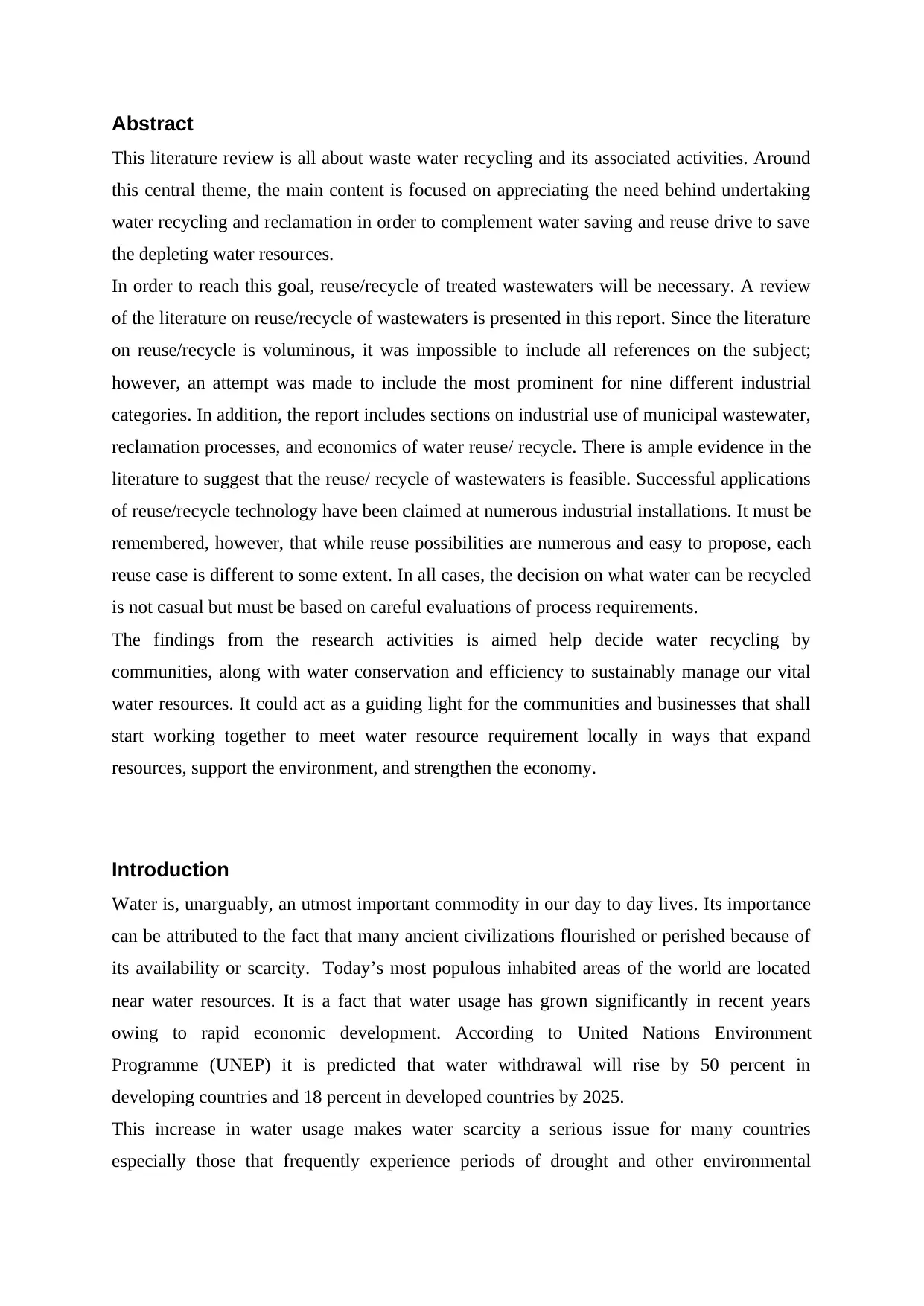
Abstract
This literature review is all about waste water recycling and its associated activities. Around
this central theme, the main content is focused on appreciating the need behind undertaking
water recycling and reclamation in order to complement water saving and reuse drive to save
the depleting water resources.
In order to reach this goal, reuse/recycle of treated wastewaters will be necessary. A review
of the literature on reuse/recycle of wastewaters is presented in this report. Since the literature
on reuse/recycle is voluminous, it was impossible to include all references on the subject;
however, an attempt was made to include the most prominent for nine different industrial
categories. In addition, the report includes sections on industrial use of municipal wastewater,
reclamation processes, and economics of water reuse/ recycle. There is ample evidence in the
literature to suggest that the reuse/ recycle of wastewaters is feasible. Successful applications
of reuse/recycle technology have been claimed at numerous industrial installations. It must be
remembered, however, that while reuse possibilities are numerous and easy to propose, each
reuse case is different to some extent. In all cases, the decision on what water can be recycled
is not casual but must be based on careful evaluations of process requirements.
The findings from the research activities is aimed help decide water recycling by
communities, along with water conservation and efficiency to sustainably manage our vital
water resources. It could act as a guiding light for the communities and businesses that shall
start working together to meet water resource requirement locally in ways that expand
resources, support the environment, and strengthen the economy.
Introduction
Water is, unarguably, an utmost important commodity in our day to day lives. Its importance
can be attributed to the fact that many ancient civilizations flourished or perished because of
its availability or scarcity. Today’s most populous inhabited areas of the world are located
near water resources. It is a fact that water usage has grown significantly in recent years
owing to rapid economic development. According to United Nations Environment
Programme (UNEP) it is predicted that water withdrawal will rise by 50 percent in
developing countries and 18 percent in developed countries by 2025.
This increase in water usage makes water scarcity a serious issue for many countries
especially those that frequently experience periods of drought and other environmental
This literature review is all about waste water recycling and its associated activities. Around
this central theme, the main content is focused on appreciating the need behind undertaking
water recycling and reclamation in order to complement water saving and reuse drive to save
the depleting water resources.
In order to reach this goal, reuse/recycle of treated wastewaters will be necessary. A review
of the literature on reuse/recycle of wastewaters is presented in this report. Since the literature
on reuse/recycle is voluminous, it was impossible to include all references on the subject;
however, an attempt was made to include the most prominent for nine different industrial
categories. In addition, the report includes sections on industrial use of municipal wastewater,
reclamation processes, and economics of water reuse/ recycle. There is ample evidence in the
literature to suggest that the reuse/ recycle of wastewaters is feasible. Successful applications
of reuse/recycle technology have been claimed at numerous industrial installations. It must be
remembered, however, that while reuse possibilities are numerous and easy to propose, each
reuse case is different to some extent. In all cases, the decision on what water can be recycled
is not casual but must be based on careful evaluations of process requirements.
The findings from the research activities is aimed help decide water recycling by
communities, along with water conservation and efficiency to sustainably manage our vital
water resources. It could act as a guiding light for the communities and businesses that shall
start working together to meet water resource requirement locally in ways that expand
resources, support the environment, and strengthen the economy.
Introduction
Water is, unarguably, an utmost important commodity in our day to day lives. Its importance
can be attributed to the fact that many ancient civilizations flourished or perished because of
its availability or scarcity. Today’s most populous inhabited areas of the world are located
near water resources. It is a fact that water usage has grown significantly in recent years
owing to rapid economic development. According to United Nations Environment
Programme (UNEP) it is predicted that water withdrawal will rise by 50 percent in
developing countries and 18 percent in developed countries by 2025.
This increase in water usage makes water scarcity a serious issue for many countries
especially those that frequently experience periods of drought and other environmental
Paraphrase This Document
Need a fresh take? Get an instant paraphrase of this document with our AI Paraphraser
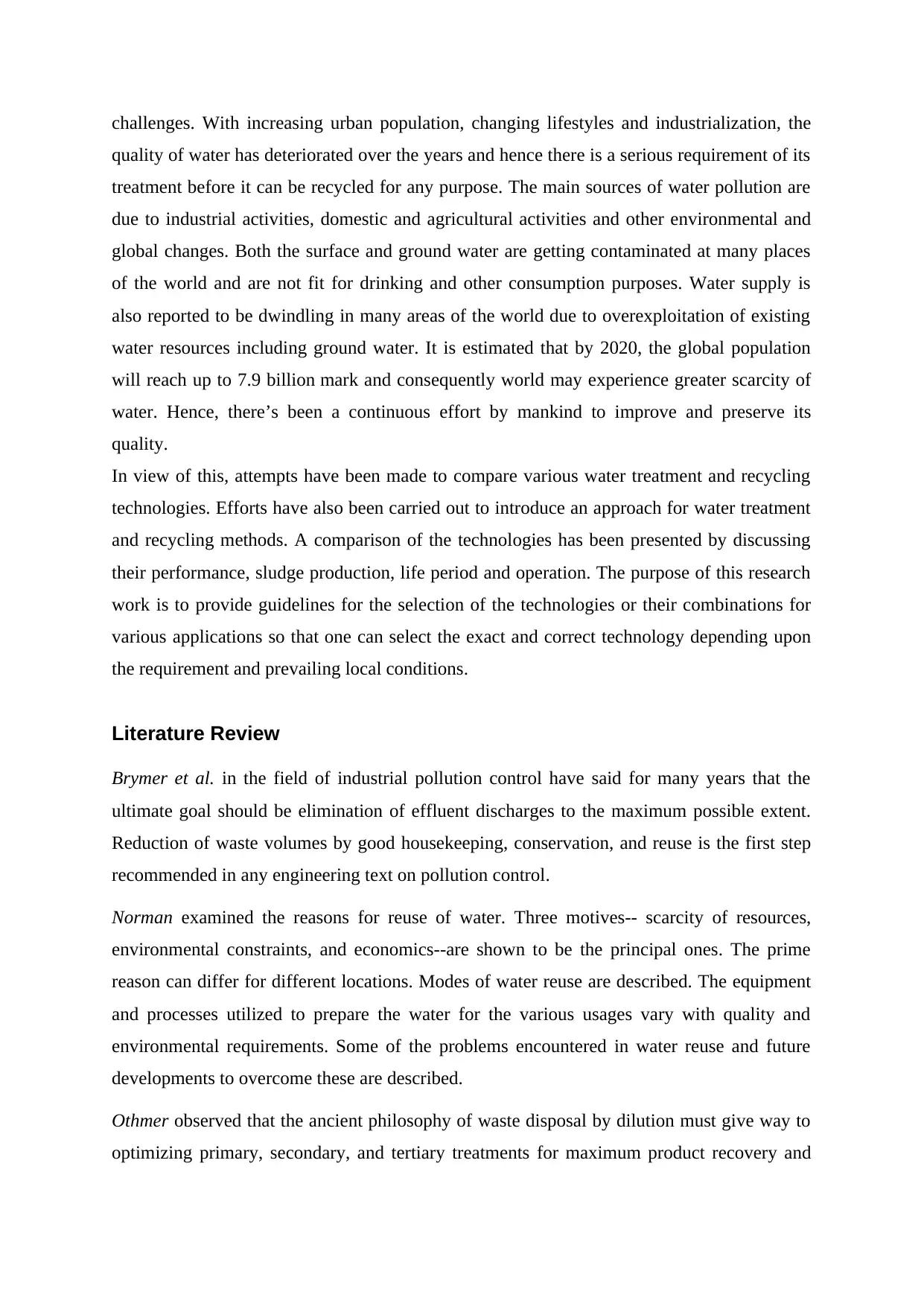
challenges. With increasing urban population, changing lifestyles and industrialization, the
quality of water has deteriorated over the years and hence there is a serious requirement of its
treatment before it can be recycled for any purpose. The main sources of water pollution are
due to industrial activities, domestic and agricultural activities and other environmental and
global changes. Both the surface and ground water are getting contaminated at many places
of the world and are not fit for drinking and other consumption purposes. Water supply is
also reported to be dwindling in many areas of the world due to overexploitation of existing
water resources including ground water. It is estimated that by 2020, the global population
will reach up to 7.9 billion mark and consequently world may experience greater scarcity of
water. Hence, there’s been a continuous effort by mankind to improve and preserve its
quality.
In view of this, attempts have been made to compare various water treatment and recycling
technologies. Efforts have also been carried out to introduce an approach for water treatment
and recycling methods. A comparison of the technologies has been presented by discussing
their performance, sludge production, life period and operation. The purpose of this research
work is to provide guidelines for the selection of the technologies or their combinations for
various applications so that one can select the exact and correct technology depending upon
the requirement and prevailing local conditions.
Literature Review
Brymer et al. in the field of industrial pollution control have said for many years that the
ultimate goal should be elimination of effluent discharges to the maximum possible extent.
Reduction of waste volumes by good housekeeping, conservation, and reuse is the first step
recommended in any engineering text on pollution control.
Norman examined the reasons for reuse of water. Three motives-- scarcity of resources,
environmental constraints, and economics--are shown to be the principal ones. The prime
reason can differ for different locations. Modes of water reuse are described. The equipment
and processes utilized to prepare the water for the various usages vary with quality and
environmental requirements. Some of the problems encountered in water reuse and future
developments to overcome these are described.
Othmer observed that the ancient philosophy of waste disposal by dilution must give way to
optimizing primary, secondary, and tertiary treatments for maximum product recovery and
quality of water has deteriorated over the years and hence there is a serious requirement of its
treatment before it can be recycled for any purpose. The main sources of water pollution are
due to industrial activities, domestic and agricultural activities and other environmental and
global changes. Both the surface and ground water are getting contaminated at many places
of the world and are not fit for drinking and other consumption purposes. Water supply is
also reported to be dwindling in many areas of the world due to overexploitation of existing
water resources including ground water. It is estimated that by 2020, the global population
will reach up to 7.9 billion mark and consequently world may experience greater scarcity of
water. Hence, there’s been a continuous effort by mankind to improve and preserve its
quality.
In view of this, attempts have been made to compare various water treatment and recycling
technologies. Efforts have also been carried out to introduce an approach for water treatment
and recycling methods. A comparison of the technologies has been presented by discussing
their performance, sludge production, life period and operation. The purpose of this research
work is to provide guidelines for the selection of the technologies or their combinations for
various applications so that one can select the exact and correct technology depending upon
the requirement and prevailing local conditions.
Literature Review
Brymer et al. in the field of industrial pollution control have said for many years that the
ultimate goal should be elimination of effluent discharges to the maximum possible extent.
Reduction of waste volumes by good housekeeping, conservation, and reuse is the first step
recommended in any engineering text on pollution control.
Norman examined the reasons for reuse of water. Three motives-- scarcity of resources,
environmental constraints, and economics--are shown to be the principal ones. The prime
reason can differ for different locations. Modes of water reuse are described. The equipment
and processes utilized to prepare the water for the various usages vary with quality and
environmental requirements. Some of the problems encountered in water reuse and future
developments to overcome these are described.
Othmer observed that the ancient philosophy of waste disposal by dilution must give way to
optimizing primary, secondary, and tertiary treatments for maximum product recovery and
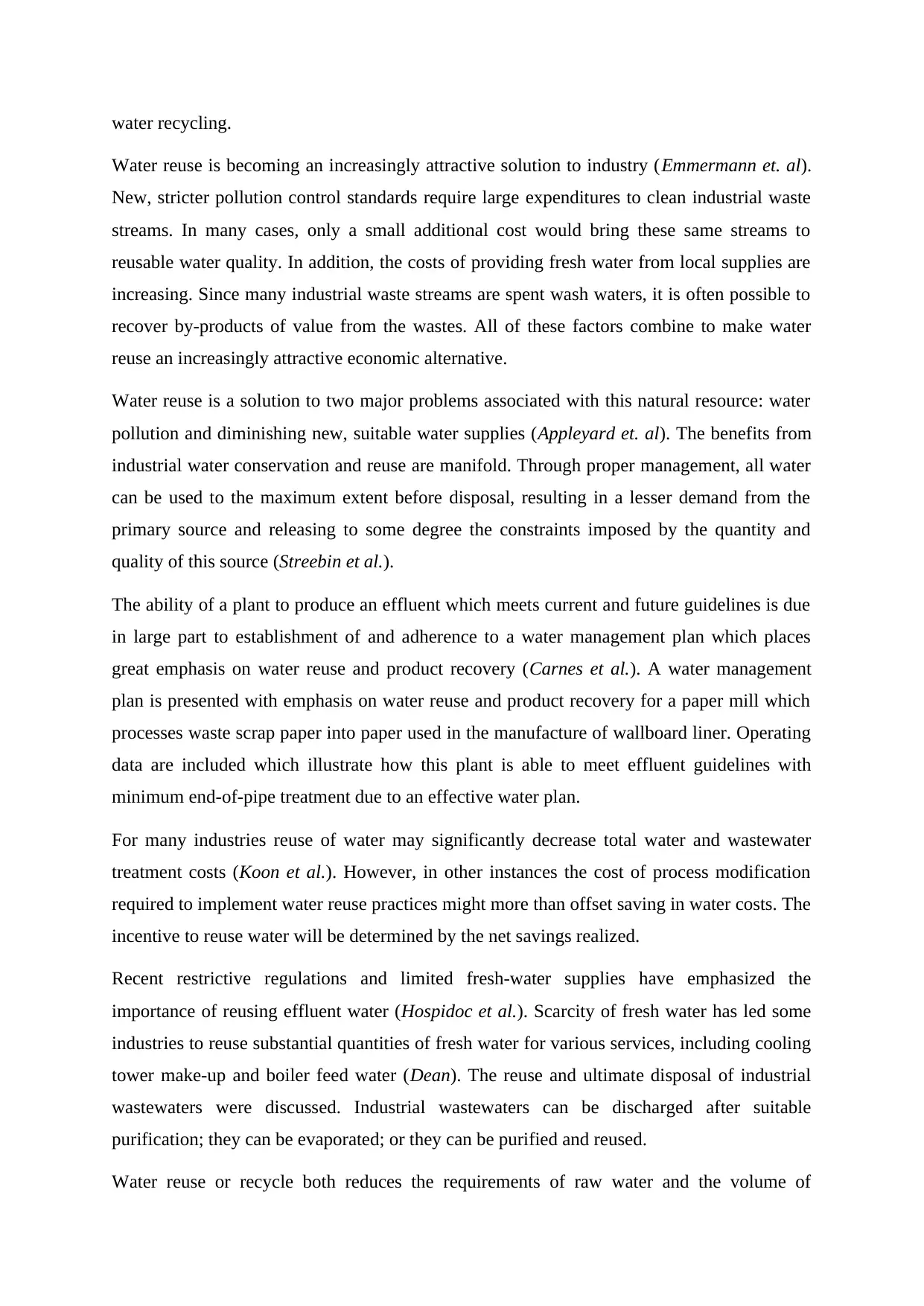
water recycling.
Water reuse is becoming an increasingly attractive solution to industry (Emmermann et. al).
New, stricter pollution control standards require large expenditures to clean industrial waste
streams. In many cases, only a small additional cost would bring these same streams to
reusable water quality. In addition, the costs of providing fresh water from local supplies are
increasing. Since many industrial waste streams are spent wash waters, it is often possible to
recover by-products of value from the wastes. All of these factors combine to make water
reuse an increasingly attractive economic alternative.
Water reuse is a solution to two major problems associated with this natural resource: water
pollution and diminishing new, suitable water supplies (Appleyard et. al). The benefits from
industrial water conservation and reuse are manifold. Through proper management, all water
can be used to the maximum extent before disposal, resulting in a lesser demand from the
primary source and releasing to some degree the constraints imposed by the quantity and
quality of this source (Streebin et al.).
The ability of a plant to produce an effluent which meets current and future guidelines is due
in large part to establishment of and adherence to a water management plan which places
great emphasis on water reuse and product recovery (Carnes et al.). A water management
plan is presented with emphasis on water reuse and product recovery for a paper mill which
processes waste scrap paper into paper used in the manufacture of wallboard liner. Operating
data are included which illustrate how this plant is able to meet effluent guidelines with
minimum end-of-pipe treatment due to an effective water plan.
For many industries reuse of water may significantly decrease total water and wastewater
treatment costs (Koon et al.). However, in other instances the cost of process modification
required to implement water reuse practices might more than offset saving in water costs. The
incentive to reuse water will be determined by the net savings realized.
Recent restrictive regulations and limited fresh-water supplies have emphasized the
importance of reusing effluent water (Hospidoc et al.). Scarcity of fresh water has led some
industries to reuse substantial quantities of fresh water for various services, including cooling
tower make-up and boiler feed water (Dean). The reuse and ultimate disposal of industrial
wastewaters were discussed. Industrial wastewaters can be discharged after suitable
purification; they can be evaporated; or they can be purified and reused.
Water reuse or recycle both reduces the requirements of raw water and the volume of
Water reuse is becoming an increasingly attractive solution to industry (Emmermann et. al).
New, stricter pollution control standards require large expenditures to clean industrial waste
streams. In many cases, only a small additional cost would bring these same streams to
reusable water quality. In addition, the costs of providing fresh water from local supplies are
increasing. Since many industrial waste streams are spent wash waters, it is often possible to
recover by-products of value from the wastes. All of these factors combine to make water
reuse an increasingly attractive economic alternative.
Water reuse is a solution to two major problems associated with this natural resource: water
pollution and diminishing new, suitable water supplies (Appleyard et. al). The benefits from
industrial water conservation and reuse are manifold. Through proper management, all water
can be used to the maximum extent before disposal, resulting in a lesser demand from the
primary source and releasing to some degree the constraints imposed by the quantity and
quality of this source (Streebin et al.).
The ability of a plant to produce an effluent which meets current and future guidelines is due
in large part to establishment of and adherence to a water management plan which places
great emphasis on water reuse and product recovery (Carnes et al.). A water management
plan is presented with emphasis on water reuse and product recovery for a paper mill which
processes waste scrap paper into paper used in the manufacture of wallboard liner. Operating
data are included which illustrate how this plant is able to meet effluent guidelines with
minimum end-of-pipe treatment due to an effective water plan.
For many industries reuse of water may significantly decrease total water and wastewater
treatment costs (Koon et al.). However, in other instances the cost of process modification
required to implement water reuse practices might more than offset saving in water costs. The
incentive to reuse water will be determined by the net savings realized.
Recent restrictive regulations and limited fresh-water supplies have emphasized the
importance of reusing effluent water (Hospidoc et al.). Scarcity of fresh water has led some
industries to reuse substantial quantities of fresh water for various services, including cooling
tower make-up and boiler feed water (Dean). The reuse and ultimate disposal of industrial
wastewaters were discussed. Industrial wastewaters can be discharged after suitable
purification; they can be evaporated; or they can be purified and reused.
Water reuse or recycle both reduces the requirements of raw water and the volume of
⊘ This is a preview!⊘
Do you want full access?
Subscribe today to unlock all pages.

Trusted by 1+ million students worldwide
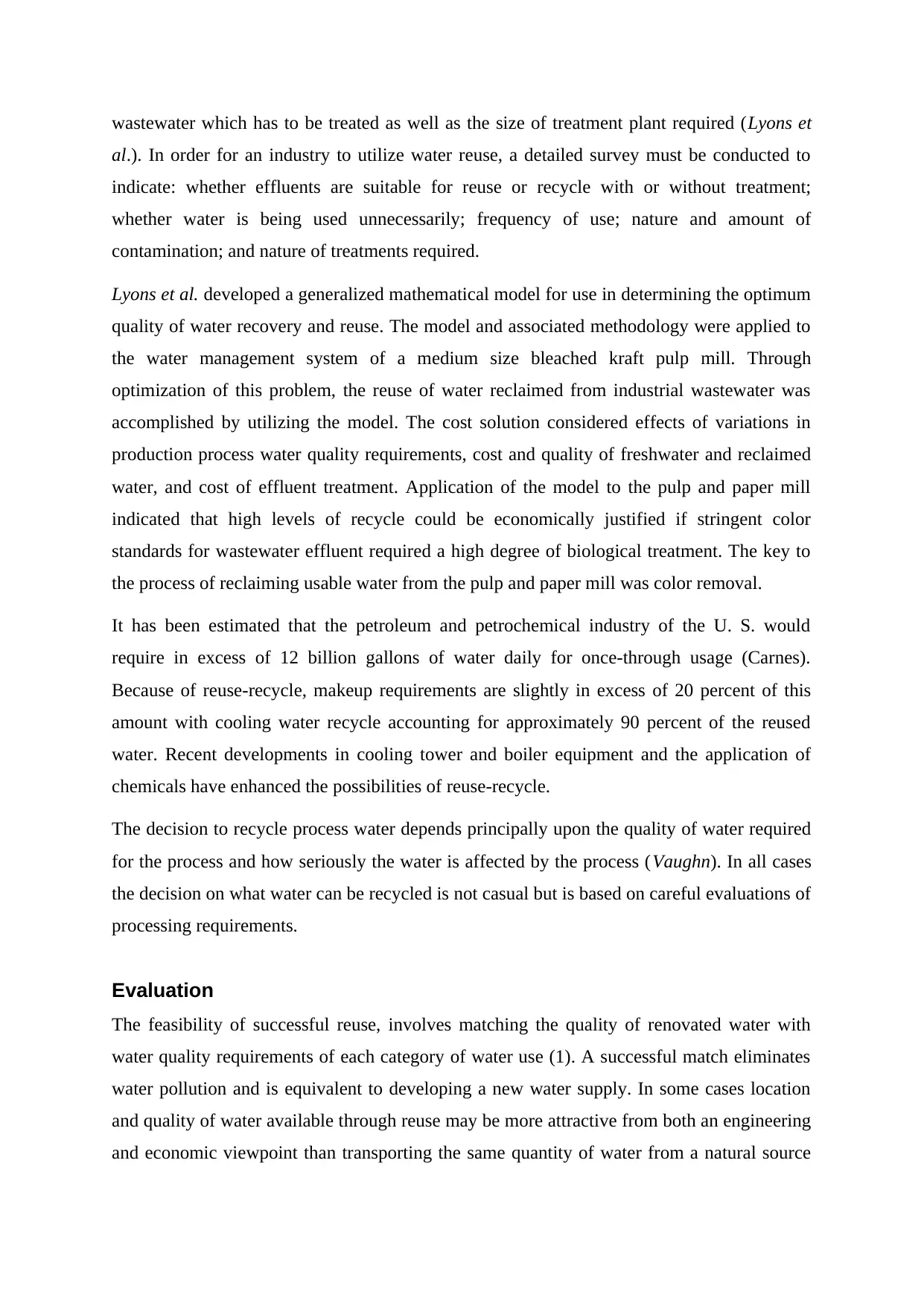
wastewater which has to be treated as well as the size of treatment plant required (Lyons et
al.). In order for an industry to utilize water reuse, a detailed survey must be conducted to
indicate: whether effluents are suitable for reuse or recycle with or without treatment;
whether water is being used unnecessarily; frequency of use; nature and amount of
contamination; and nature of treatments required.
Lyons et al. developed a generalized mathematical model for use in determining the optimum
quality of water recovery and reuse. The model and associated methodology were applied to
the water management system of a medium size bleached kraft pulp mill. Through
optimization of this problem, the reuse of water reclaimed from industrial wastewater was
accomplished by utilizing the model. The cost solution considered effects of variations in
production process water quality requirements, cost and quality of freshwater and reclaimed
water, and cost of effluent treatment. Application of the model to the pulp and paper mill
indicated that high levels of recycle could be economically justified if stringent color
standards for wastewater effluent required a high degree of biological treatment. The key to
the process of reclaiming usable water from the pulp and paper mill was color removal.
It has been estimated that the petroleum and petrochemical industry of the U. S. would
require in excess of 12 billion gallons of water daily for once-through usage (Carnes).
Because of reuse-recycle, makeup requirements are slightly in excess of 20 percent of this
amount with cooling water recycle accounting for approximately 90 percent of the reused
water. Recent developments in cooling tower and boiler equipment and the application of
chemicals have enhanced the possibilities of reuse-recycle.
The decision to recycle process water depends principally upon the quality of water required
for the process and how seriously the water is affected by the process (Vaughn). In all cases
the decision on what water can be recycled is not casual but is based on careful evaluations of
processing requirements.
Evaluation
The feasibility of successful reuse, involves matching the quality of renovated water with
water quality requirements of each category of water use (1). A successful match eliminates
water pollution and is equivalent to developing a new water supply. In some cases location
and quality of water available through reuse may be more attractive from both an engineering
and economic viewpoint than transporting the same quantity of water from a natural source
al.). In order for an industry to utilize water reuse, a detailed survey must be conducted to
indicate: whether effluents are suitable for reuse or recycle with or without treatment;
whether water is being used unnecessarily; frequency of use; nature and amount of
contamination; and nature of treatments required.
Lyons et al. developed a generalized mathematical model for use in determining the optimum
quality of water recovery and reuse. The model and associated methodology were applied to
the water management system of a medium size bleached kraft pulp mill. Through
optimization of this problem, the reuse of water reclaimed from industrial wastewater was
accomplished by utilizing the model. The cost solution considered effects of variations in
production process water quality requirements, cost and quality of freshwater and reclaimed
water, and cost of effluent treatment. Application of the model to the pulp and paper mill
indicated that high levels of recycle could be economically justified if stringent color
standards for wastewater effluent required a high degree of biological treatment. The key to
the process of reclaiming usable water from the pulp and paper mill was color removal.
It has been estimated that the petroleum and petrochemical industry of the U. S. would
require in excess of 12 billion gallons of water daily for once-through usage (Carnes).
Because of reuse-recycle, makeup requirements are slightly in excess of 20 percent of this
amount with cooling water recycle accounting for approximately 90 percent of the reused
water. Recent developments in cooling tower and boiler equipment and the application of
chemicals have enhanced the possibilities of reuse-recycle.
The decision to recycle process water depends principally upon the quality of water required
for the process and how seriously the water is affected by the process (Vaughn). In all cases
the decision on what water can be recycled is not casual but is based on careful evaluations of
processing requirements.
Evaluation
The feasibility of successful reuse, involves matching the quality of renovated water with
water quality requirements of each category of water use (1). A successful match eliminates
water pollution and is equivalent to developing a new water supply. In some cases location
and quality of water available through reuse may be more attractive from both an engineering
and economic viewpoint than transporting the same quantity of water from a natural source
Paraphrase This Document
Need a fresh take? Get an instant paraphrase of this document with our AI Paraphraser
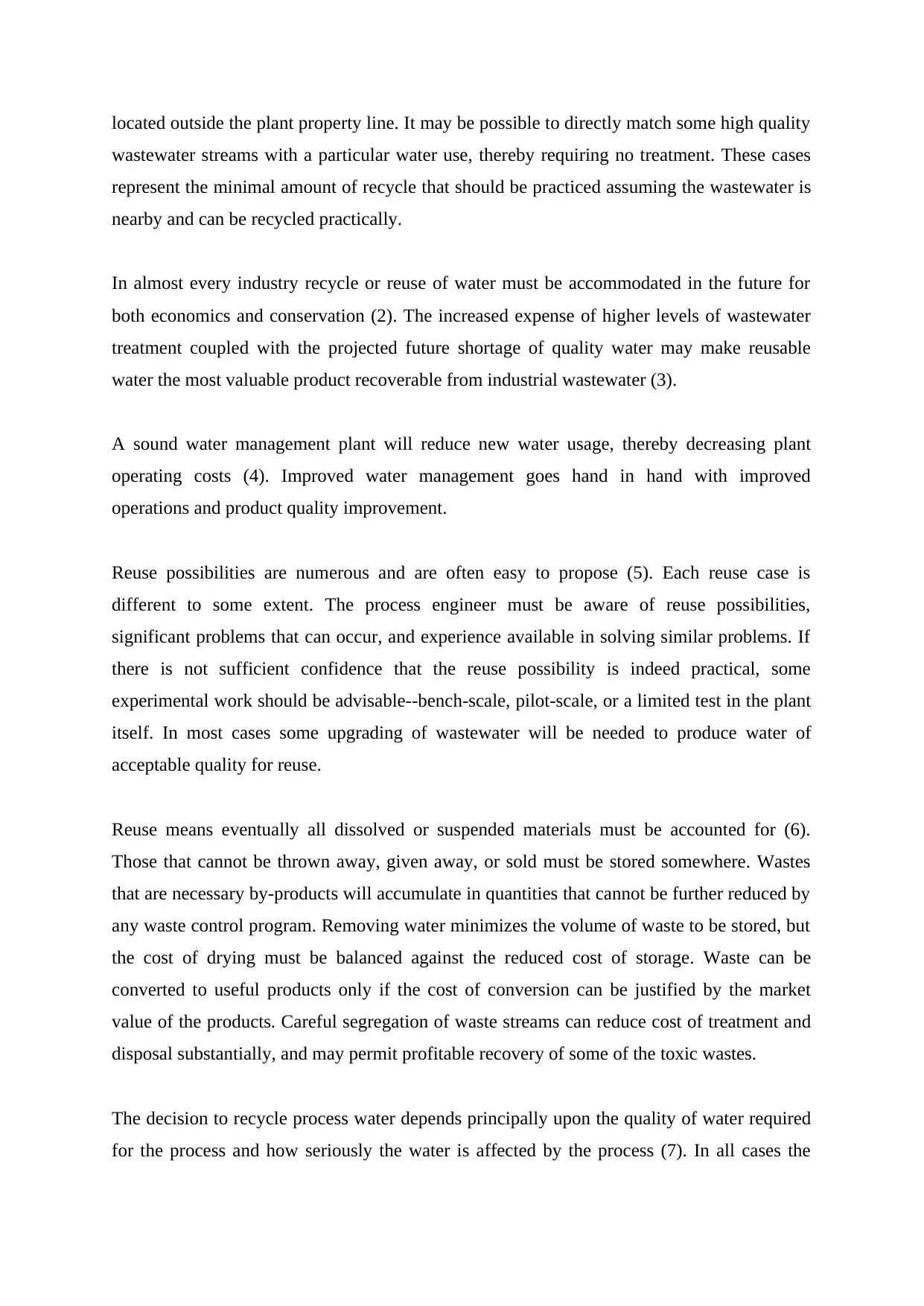
located outside the plant property line. It may be possible to directly match some high quality
wastewater streams with a particular water use, thereby requiring no treatment. These cases
represent the minimal amount of recycle that should be practiced assuming the wastewater is
nearby and can be recycled practically.
In almost every industry recycle or reuse of water must be accommodated in the future for
both economics and conservation (2). The increased expense of higher levels of wastewater
treatment coupled with the projected future shortage of quality water may make reusable
water the most valuable product recoverable from industrial wastewater (3).
A sound water management plant will reduce new water usage, thereby decreasing plant
operating costs (4). Improved water management goes hand in hand with improved
operations and product quality improvement.
Reuse possibilities are numerous and are often easy to propose (5). Each reuse case is
different to some extent. The process engineer must be aware of reuse possibilities,
significant problems that can occur, and experience available in solving similar problems. If
there is not sufficient confidence that the reuse possibility is indeed practical, some
experimental work should be advisable--bench-scale, pilot-scale, or a limited test in the plant
itself. In most cases some upgrading of wastewater will be needed to produce water of
acceptable quality for reuse.
Reuse means eventually all dissolved or suspended materials must be accounted for (6).
Those that cannot be thrown away, given away, or sold must be stored somewhere. Wastes
that are necessary by-products will accumulate in quantities that cannot be further reduced by
any waste control program. Removing water minimizes the volume of waste to be stored, but
the cost of drying must be balanced against the reduced cost of storage. Waste can be
converted to useful products only if the cost of conversion can be justified by the market
value of the products. Careful segregation of waste streams can reduce cost of treatment and
disposal substantially, and may permit profitable recovery of some of the toxic wastes.
The decision to recycle process water depends principally upon the quality of water required
for the process and how seriously the water is affected by the process (7). In all cases the
wastewater streams with a particular water use, thereby requiring no treatment. These cases
represent the minimal amount of recycle that should be practiced assuming the wastewater is
nearby and can be recycled practically.
In almost every industry recycle or reuse of water must be accommodated in the future for
both economics and conservation (2). The increased expense of higher levels of wastewater
treatment coupled with the projected future shortage of quality water may make reusable
water the most valuable product recoverable from industrial wastewater (3).
A sound water management plant will reduce new water usage, thereby decreasing plant
operating costs (4). Improved water management goes hand in hand with improved
operations and product quality improvement.
Reuse possibilities are numerous and are often easy to propose (5). Each reuse case is
different to some extent. The process engineer must be aware of reuse possibilities,
significant problems that can occur, and experience available in solving similar problems. If
there is not sufficient confidence that the reuse possibility is indeed practical, some
experimental work should be advisable--bench-scale, pilot-scale, or a limited test in the plant
itself. In most cases some upgrading of wastewater will be needed to produce water of
acceptable quality for reuse.
Reuse means eventually all dissolved or suspended materials must be accounted for (6).
Those that cannot be thrown away, given away, or sold must be stored somewhere. Wastes
that are necessary by-products will accumulate in quantities that cannot be further reduced by
any waste control program. Removing water minimizes the volume of waste to be stored, but
the cost of drying must be balanced against the reduced cost of storage. Waste can be
converted to useful products only if the cost of conversion can be justified by the market
value of the products. Careful segregation of waste streams can reduce cost of treatment and
disposal substantially, and may permit profitable recovery of some of the toxic wastes.
The decision to recycle process water depends principally upon the quality of water required
for the process and how seriously the water is affected by the process (7). In all cases the
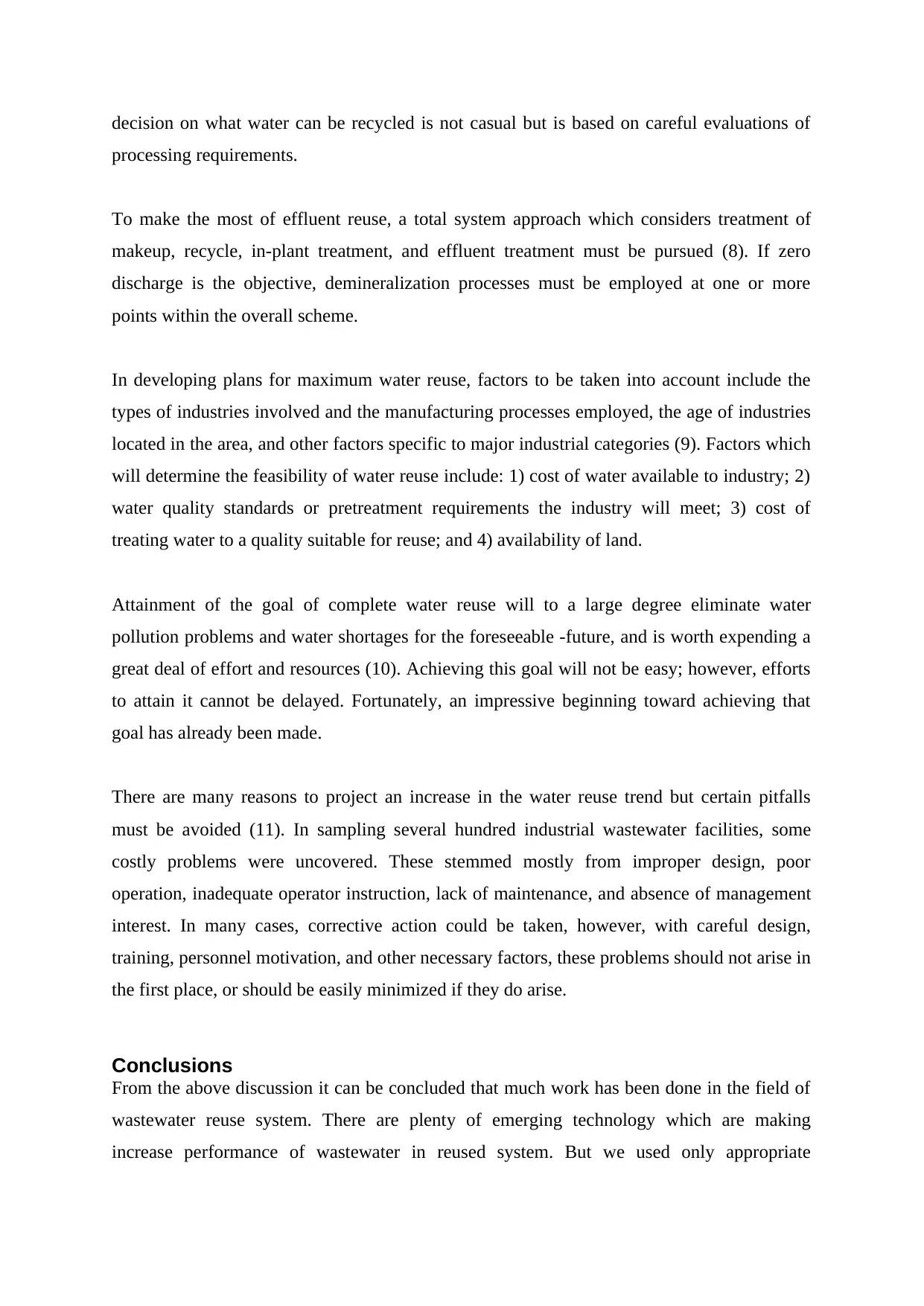
decision on what water can be recycled is not casual but is based on careful evaluations of
processing requirements.
To make the most of effluent reuse, a total system approach which considers treatment of
makeup, recycle, in-plant treatment, and effluent treatment must be pursued (8). If zero
discharge is the objective, demineralization processes must be employed at one or more
points within the overall scheme.
In developing plans for maximum water reuse, factors to be taken into account include the
types of industries involved and the manufacturing processes employed, the age of industries
located in the area, and other factors specific to major industrial categories (9). Factors which
will determine the feasibility of water reuse include: 1) cost of water available to industry; 2)
water quality standards or pretreatment requirements the industry will meet; 3) cost of
treating water to a quality suitable for reuse; and 4) availability of land.
Attainment of the goal of complete water reuse will to a large degree eliminate water
pollution problems and water shortages for the foreseeable -future, and is worth expending a
great deal of effort and resources (10). Achieving this goal will not be easy; however, efforts
to attain it cannot be delayed. Fortunately, an impressive beginning toward achieving that
goal has already been made.
There are many reasons to project an increase in the water reuse trend but certain pitfalls
must be avoided (11). In sampling several hundred industrial wastewater facilities, some
costly problems were uncovered. These stemmed mostly from improper design, poor
operation, inadequate operator instruction, lack of maintenance, and absence of management
interest. In many cases, corrective action could be taken, however, with careful design,
training, personnel motivation, and other necessary factors, these problems should not arise in
the first place, or should be easily minimized if they do arise.
Conclusions
From the above discussion it can be concluded that much work has been done in the field of
wastewater reuse system. There are plenty of emerging technology which are making
increase performance of wastewater in reused system. But we used only appropriate
processing requirements.
To make the most of effluent reuse, a total system approach which considers treatment of
makeup, recycle, in-plant treatment, and effluent treatment must be pursued (8). If zero
discharge is the objective, demineralization processes must be employed at one or more
points within the overall scheme.
In developing plans for maximum water reuse, factors to be taken into account include the
types of industries involved and the manufacturing processes employed, the age of industries
located in the area, and other factors specific to major industrial categories (9). Factors which
will determine the feasibility of water reuse include: 1) cost of water available to industry; 2)
water quality standards or pretreatment requirements the industry will meet; 3) cost of
treating water to a quality suitable for reuse; and 4) availability of land.
Attainment of the goal of complete water reuse will to a large degree eliminate water
pollution problems and water shortages for the foreseeable -future, and is worth expending a
great deal of effort and resources (10). Achieving this goal will not be easy; however, efforts
to attain it cannot be delayed. Fortunately, an impressive beginning toward achieving that
goal has already been made.
There are many reasons to project an increase in the water reuse trend but certain pitfalls
must be avoided (11). In sampling several hundred industrial wastewater facilities, some
costly problems were uncovered. These stemmed mostly from improper design, poor
operation, inadequate operator instruction, lack of maintenance, and absence of management
interest. In many cases, corrective action could be taken, however, with careful design,
training, personnel motivation, and other necessary factors, these problems should not arise in
the first place, or should be easily minimized if they do arise.
Conclusions
From the above discussion it can be concluded that much work has been done in the field of
wastewater reuse system. There are plenty of emerging technology which are making
increase performance of wastewater in reused system. But we used only appropriate
⊘ This is a preview!⊘
Do you want full access?
Subscribe today to unlock all pages.

Trusted by 1+ million students worldwide
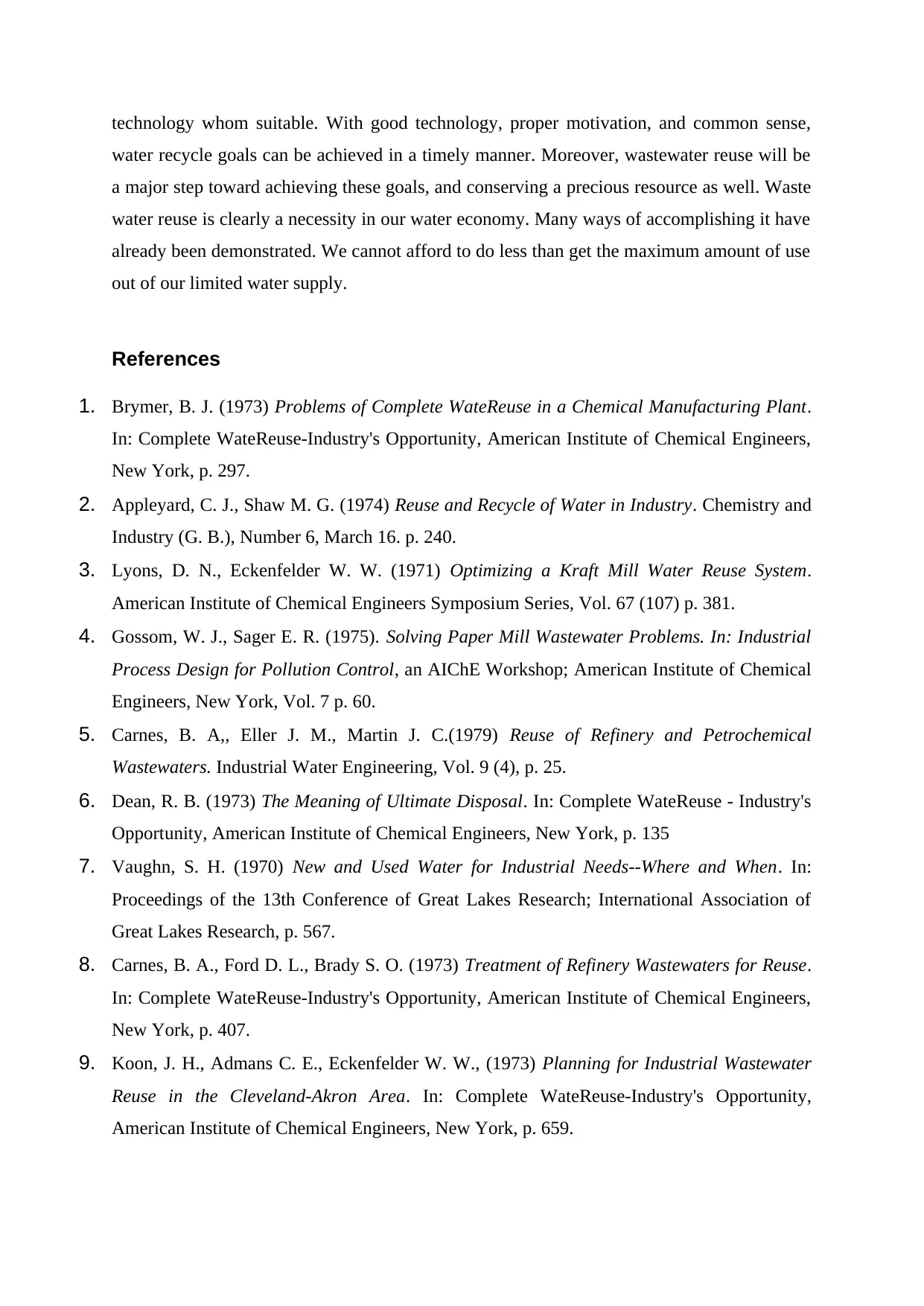
technology whom suitable. With good technology, proper motivation, and common sense,
water recycle goals can be achieved in a timely manner. Moreover, wastewater reuse will be
a major step toward achieving these goals, and conserving a precious resource as well. Waste
water reuse is clearly a necessity in our water economy. Many ways of accomplishing it have
already been demonstrated. We cannot afford to do less than get the maximum amount of use
out of our limited water supply.
References
1. Brymer, B. J. (1973) Problems of Complete WateReuse in a Chemical Manufacturing Plant.
In: Complete WateReuse-Industry's Opportunity, American Institute of Chemical Engineers,
New York, p. 297.
2. Appleyard, C. J., Shaw M. G. (1974) Reuse and Recycle of Water in Industry. Chemistry and
Industry (G. B.), Number 6, March 16. p. 240.
3. Lyons, D. N., Eckenfelder W. W. (1971) Optimizing a Kraft Mill Water Reuse System.
American Institute of Chemical Engineers Symposium Series, Vol. 67 (107) p. 381.
4. Gossom, W. J., Sager E. R. (1975). Solving Paper Mill Wastewater Problems. In: Industrial
Process Design for Pollution Control, an AIChE Workshop; American Institute of Chemical
Engineers, New York, Vol. 7 p. 60.
5. Carnes, B. A,, Eller J. M., Martin J. C.(1979) Reuse of Refinery and Petrochemical
Wastewaters. Industrial Water Engineering, Vol. 9 (4), p. 25.
6. Dean, R. B. (1973) The Meaning of Ultimate Disposal. In: Complete WateReuse - Industry's
Opportunity, American Institute of Chemical Engineers, New York, p. 135
7. Vaughn, S. H. (1970) New and Used Water for Industrial Needs--Where and When. In:
Proceedings of the 13th Conference of Great Lakes Research; International Association of
Great Lakes Research, p. 567.
8. Carnes, B. A., Ford D. L., Brady S. O. (1973) Treatment of Refinery Wastewaters for Reuse.
In: Complete WateReuse-Industry's Opportunity, American Institute of Chemical Engineers,
New York, p. 407.
9. Koon, J. H., Admans C. E., Eckenfelder W. W., (1973) Planning for Industrial Wastewater
Reuse in the Cleveland-Akron Area. In: Complete WateReuse-Industry's Opportunity,
American Institute of Chemical Engineers, New York, p. 659.
water recycle goals can be achieved in a timely manner. Moreover, wastewater reuse will be
a major step toward achieving these goals, and conserving a precious resource as well. Waste
water reuse is clearly a necessity in our water economy. Many ways of accomplishing it have
already been demonstrated. We cannot afford to do less than get the maximum amount of use
out of our limited water supply.
References
1. Brymer, B. J. (1973) Problems of Complete WateReuse in a Chemical Manufacturing Plant.
In: Complete WateReuse-Industry's Opportunity, American Institute of Chemical Engineers,
New York, p. 297.
2. Appleyard, C. J., Shaw M. G. (1974) Reuse and Recycle of Water in Industry. Chemistry and
Industry (G. B.), Number 6, March 16. p. 240.
3. Lyons, D. N., Eckenfelder W. W. (1971) Optimizing a Kraft Mill Water Reuse System.
American Institute of Chemical Engineers Symposium Series, Vol. 67 (107) p. 381.
4. Gossom, W. J., Sager E. R. (1975). Solving Paper Mill Wastewater Problems. In: Industrial
Process Design for Pollution Control, an AIChE Workshop; American Institute of Chemical
Engineers, New York, Vol. 7 p. 60.
5. Carnes, B. A,, Eller J. M., Martin J. C.(1979) Reuse of Refinery and Petrochemical
Wastewaters. Industrial Water Engineering, Vol. 9 (4), p. 25.
6. Dean, R. B. (1973) The Meaning of Ultimate Disposal. In: Complete WateReuse - Industry's
Opportunity, American Institute of Chemical Engineers, New York, p. 135
7. Vaughn, S. H. (1970) New and Used Water for Industrial Needs--Where and When. In:
Proceedings of the 13th Conference of Great Lakes Research; International Association of
Great Lakes Research, p. 567.
8. Carnes, B. A., Ford D. L., Brady S. O. (1973) Treatment of Refinery Wastewaters for Reuse.
In: Complete WateReuse-Industry's Opportunity, American Institute of Chemical Engineers,
New York, p. 407.
9. Koon, J. H., Admans C. E., Eckenfelder W. W., (1973) Planning for Industrial Wastewater
Reuse in the Cleveland-Akron Area. In: Complete WateReuse-Industry's Opportunity,
American Institute of Chemical Engineers, New York, p. 659.
Paraphrase This Document
Need a fresh take? Get an instant paraphrase of this document with our AI Paraphraser
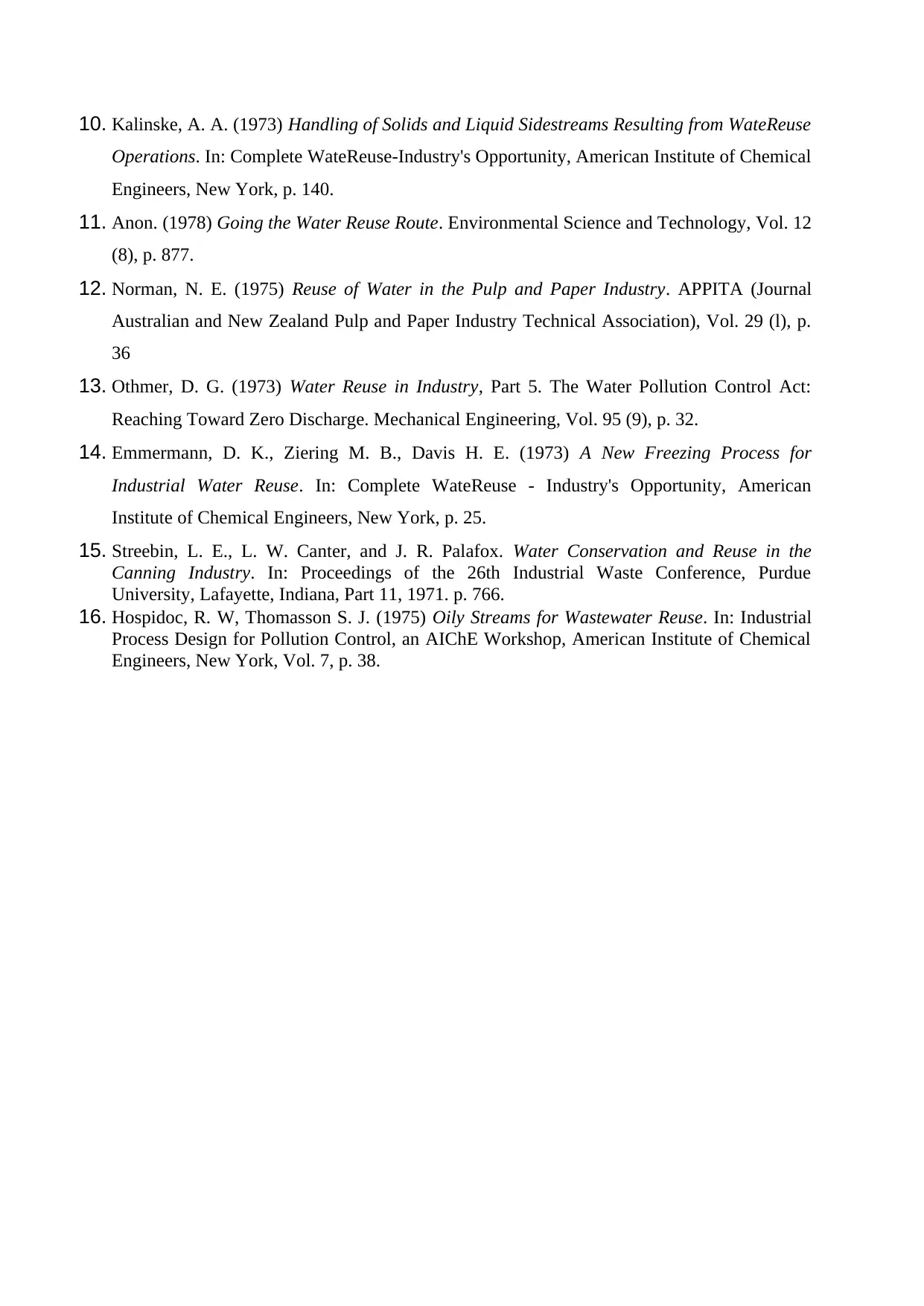
10. Kalinske, A. A. (1973) Handling of Solids and Liquid Sidestreams Resulting from WateReuse
Operations. In: Complete WateReuse-Industry's Opportunity, American Institute of Chemical
Engineers, New York, p. 140.
11. Anon. (1978) Going the Water Reuse Route. Environmental Science and Technology, Vol. 12
(8), p. 877.
12. Norman, N. E. (1975) Reuse of Water in the Pulp and Paper Industry. APPITA (Journal
Australian and New Zealand Pulp and Paper Industry Technical Association), Vol. 29 (l), p.
36
13. Othmer, D. G. (1973) Water Reuse in Industry, Part 5. The Water Pollution Control Act:
Reaching Toward Zero Discharge. Mechanical Engineering, Vol. 95 (9), p. 32.
14. Emmermann, D. K., Ziering M. B., Davis H. E. (1973) A New Freezing Process for
Industrial Water Reuse. In: Complete WateReuse - Industry's Opportunity, American
Institute of Chemical Engineers, New York, p. 25.
15. Streebin, L. E., L. W. Canter, and J. R. Palafox. Water Conservation and Reuse in the
Canning Industry. In: Proceedings of the 26th Industrial Waste Conference, Purdue
University, Lafayette, Indiana, Part 11, 1971. p. 766.
16. Hospidoc, R. W, Thomasson S. J. (1975) Oily Streams for Wastewater Reuse. In: Industrial
Process Design for Pollution Control, an AIChE Workshop, American Institute of Chemical
Engineers, New York, Vol. 7, p. 38.
Operations. In: Complete WateReuse-Industry's Opportunity, American Institute of Chemical
Engineers, New York, p. 140.
11. Anon. (1978) Going the Water Reuse Route. Environmental Science and Technology, Vol. 12
(8), p. 877.
12. Norman, N. E. (1975) Reuse of Water in the Pulp and Paper Industry. APPITA (Journal
Australian and New Zealand Pulp and Paper Industry Technical Association), Vol. 29 (l), p.
36
13. Othmer, D. G. (1973) Water Reuse in Industry, Part 5. The Water Pollution Control Act:
Reaching Toward Zero Discharge. Mechanical Engineering, Vol. 95 (9), p. 32.
14. Emmermann, D. K., Ziering M. B., Davis H. E. (1973) A New Freezing Process for
Industrial Water Reuse. In: Complete WateReuse - Industry's Opportunity, American
Institute of Chemical Engineers, New York, p. 25.
15. Streebin, L. E., L. W. Canter, and J. R. Palafox. Water Conservation and Reuse in the
Canning Industry. In: Proceedings of the 26th Industrial Waste Conference, Purdue
University, Lafayette, Indiana, Part 11, 1971. p. 766.
16. Hospidoc, R. W, Thomasson S. J. (1975) Oily Streams for Wastewater Reuse. In: Industrial
Process Design for Pollution Control, an AIChE Workshop, American Institute of Chemical
Engineers, New York, Vol. 7, p. 38.
1 out of 8
Related Documents
Your All-in-One AI-Powered Toolkit for Academic Success.
+13062052269
info@desklib.com
Available 24*7 on WhatsApp / Email
![[object Object]](/_next/static/media/star-bottom.7253800d.svg)
Unlock your academic potential
Copyright © 2020–2025 A2Z Services. All Rights Reserved. Developed and managed by ZUCOL.





